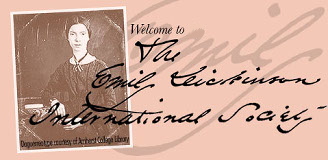“Alone and in a Circumstance”:
Spiders, Artistry, and Dickinson’s Letter to George Sand
Elizabeth Petrino, Fairfield University
This paper explores the imagery of artistry and the transatlantic connections between Emily Dickinson and the continental writer, George Sand, who fascinated her and others of her generation. Written about 1870, her poem “Alone and in a Circumstance” has curiously an uncancelled, three-cent postage stamp placed in the middle of the page with two clippings from Harper’s Magazine, the names “George Sand” and “Mauprat.” In “Alone and in a Circumstance” (F 1174), Dickinson elliptically alludes to Sand’s life and reveals an alternate model of female artistic creativity that simultaneously attracted and repelled her. Tracing her cut-outs to the issue from which the poet clipped the names, I argue that two articles are relevant to her understanding of Sand’s life: the first, which appeared in “Editor’s Easy Chair,” describes the publisher receiving a letter that seeks signatures from “distinguished personages” with whom the editor might have been in contact. The second appears in “Editor’s Literary Record” and reviews Sand’s novel, Mauprat, a novel whose central character is a bandit and outlaw. Not only do these articles suggest the dimensions of Sand’s life that would have fascinated her—her separation from her husband, bohemian life, habit of writing at night in her garret, transvestism, and rejection of fame—but they closely parallel aspects of Dickinson’s poem that suggest she imported, albeit without naming her, aspects of Sand’s life into her own imaginative “letter” to the writer.
Employing the language of the law, Dickinson is concerned with her dispossession not only of physical space but also of the privacy needed to write and feels impelled to find an alternate space in which to create. The specter of physical assault or larceny, which can be righted by law, is displaced by an “offence” that is harder to name—a “Larceny of time and mind” for which there is no “redress.” Dickinson no doubt felt the imposition on her time as a robbery and fantasized the connection to George Sand, the artist, gender transgressor, and bohemian, and Mauprat, the bandit, outlaw, and passionate lover, as two sides of a character that represented a romanticized ideal. Far from a poem only about a mere domestic ritual, a comic entertainment, or a private affair, the lyric transcends any single critical interpretation and encompasses more broadly the possibility that she was engaged imaginatively with the role of the female artist.
